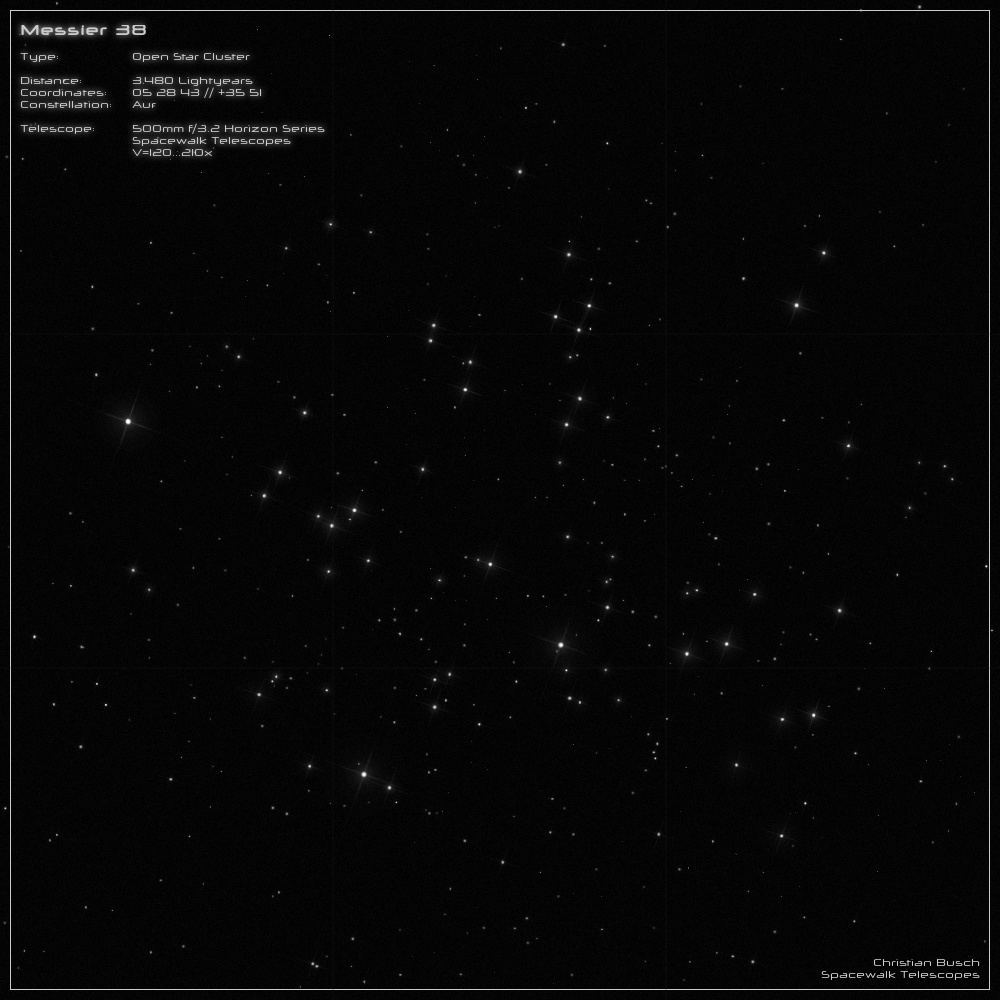Messier 38, "Starfish Cluster"
Messier 38 is also one of the three large Auriga clusters and with an apparent visual magnitude of +6.4mag can be seen even in small binoculars.
Because of its shape it is also called "Starfish Cluster" or "Pi- Cluster", the former version is much more common.
The distance to Messier 38 is given with nearly 3,500 lightyears. Therefore it is about 1,000 light-years closer to Earth than Messier 36 and 37.
The apparent diameter in the sky is 20', which corresponds to a true diameter of 15 to 20 light-years.
About 600 stars are estimated to belong to the cluster. The brightest one has a brightness of +7.9mag and belongs to the spectral type G0, so it
has an almost identical surface temperature as our sun. What distinguishes it from our sun is its absolute brightness of -2.3mag, which is the
equivalent of 700 solar luminosities. Even at a distance of 12 light years it would still shine as brightly as our sister planet Venus. With this
immense luminosity, this particular star belongs to the group of "yellow giant stars". But there is another interesting star in Messier 38 - named
"BD +35° 1111". It is the only known "Be-star" in Messier 38. These stars are characterized by a high rotational velocity, which leads to a strong
flattening. Some of these stars even have a ring of hot gas over the equator.
The age of Messier 38 is given with 290 to 320 million years. So it is neither very young nor very old, but somehow in the middle of it - so in
the best age you could say.
If you have seen the star cluster in the telescope before, you might have noticed the small star cluster NGC 1907 half a degree south. It is in a
similar distance as Messier 38, so the suspicion is that this is a double cluster. A 1937 scientific paper even mentioned the possibility that the
two clusters might orbit each other - once in about 10 million years. But recent research suggests that the clusters formed in different parts of
the galaxy and are currently flying past each other only a short distance apart - a cosmic fly-by, so to speak. Really exciting! :)
----------------------------------------------------------------------------------------------------------------------------------------------
So what of this can be seen in a 20 inch telescope?
As with the other two large Auriga star clusters, the sight of Messier 38 in such a large telescope will be remembered for a long time, because
it is simply stunning. Because the cluster is quite large and loosely concentrated, it is best to choose a lower magnification. In my case this was
120x. The whole field of view is filled with bright and fainter stars. The shape actually reminds a bit of the Greek letter "Pi". But much more
memorable to me seems to be a rombus - that is, a shape similar to that of a polished diamond. This also fits quite well with the bright sparkle
and glitter in the eyepiece. :)
The brightest star at the eastern edge of the cluster shines in a warm yellow hue and can therefore easily be identified as the yellow giant star
described above. The stellar density of countless fainter stars is highest in the southern part of the cluster. The center, on the other hand, appears
quite empty except for a small triple chain of fainter stars.

